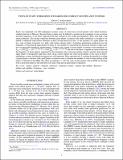TESTS OF IN SITU FORMATION SCENARIOS FOR COMPACT MULTIPLANET SYSTEMS
Author(s)
Schlaufman, Kevin C
DownloadSchlaufman-2014-Tests of in situ for.pdf (575.4Kb)
PUBLISHER_POLICY
Publisher Policy
Article is made available in accordance with the publisher's policy and may be subject to US copyright law. Please refer to the publisher's site for terms of use.
Terms of use
Metadata
Show full item recordAbstract
Kepler has identified over 600 multiplanet systems, many of which have several planets with orbital distances smaller than that of Mercury. Because these systems may be difficult to explain in the paradigm of core accretion and disk migration, it has been suggested that they formed in situ within protoplanetary disks with high solid surface densities. The strong connection between giant planet occurrence and stellar metallicity is thought to be linked to enhanced solid surface densities in disks around metal-rich stars, so the presence of a giant planet can be a sign of planet formation in a high solid surface density disk. I formulate quantitative predictions for the frequency of long-period giant planets in these in situ models by translating the proposed increase in disk mass into an equivalent metallicity enhancement. I rederive the scaling of giant planet occurrence with metallicity as P[subscript gp] = 0.05[+0.02 over -0.02] X 10[superscript (2.1 ± 0.4)[M/H]] = 0.08[+0.02 over -0.03] X 10[superscript (2.3 ± 0.4)[Fe/H]] and show that there is significant tension between the frequency of giant planets suggested by the minimum mass extrasolar nebula scenario and the observational upper limits. Consequently, high-mass disks alone cannot explain the observed properties of the close-in Kepler multiplanet systems and therefore migration is still important. More speculatively, I combine the metallicity scaling of giant planet occurrence with small planet occurrence rates to estimate the number of solar system analogs in the Galaxy. I find that in the Milky Way there are perhaps 4 × 10[superscript 6] true solar system analogs with an FGK star hosting both a terrestrial planet in the habitable zone and a long-period giant planet companion.
Date issued
2014-07Department
MIT Kavli Institute for Astrophysics and Space ResearchJournal
The Astrophysical Journal
Publisher
IOP Publishing
Citation
Schlaufman, Kevin C. “TESTS OF IN SITU FORMATION SCENARIOS FOR COMPACT MULTIPLANET SYSTEMS.” The Astrophysical Journal 790, no. 2 (July 9, 2014): 91. © 2014 The American Astronomical Society
Version: Final published version
ISSN
0004-637X
1538-4357